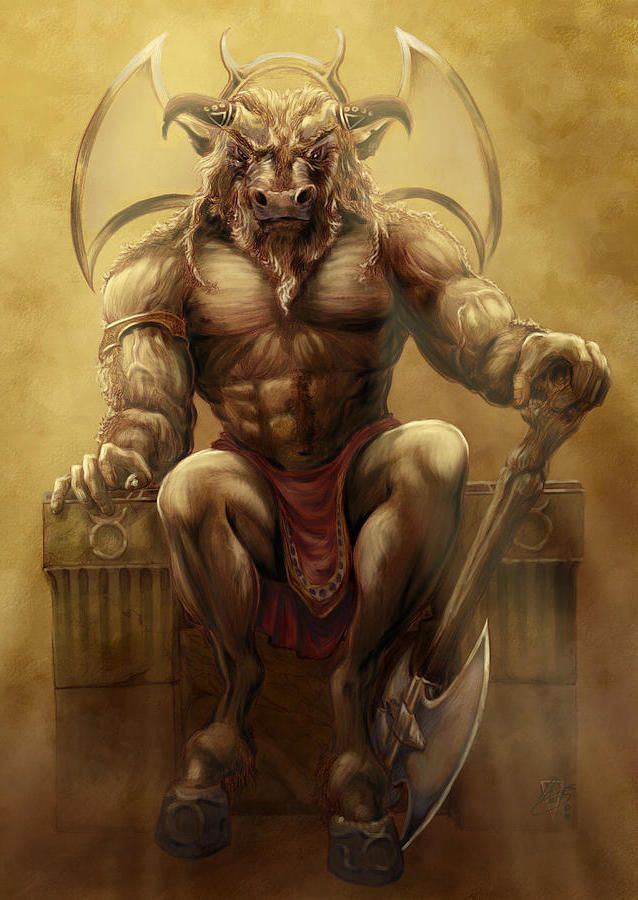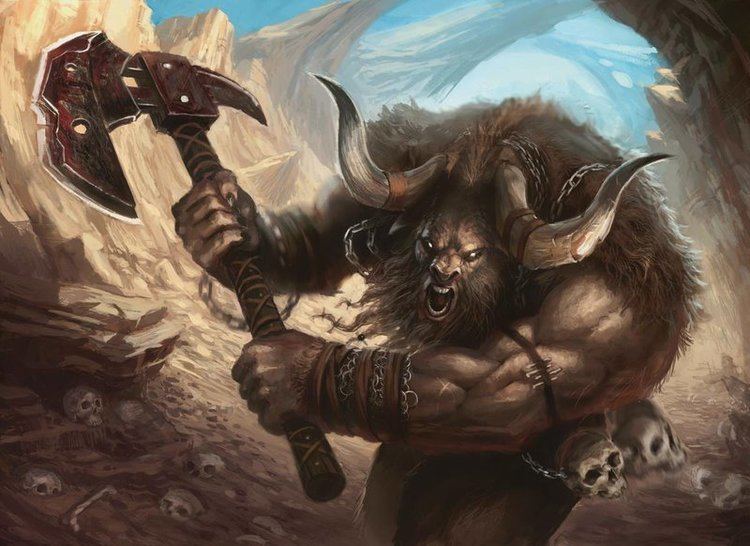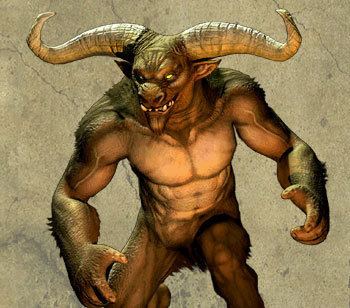Mythology Greek Played by Paul Kasey | Region Crete Grouping Legendary creature | |
 | ||
Parents Cretan Bull and Pasiphaë Movies Wrath of the Titans, Inkheart, Titans Of Newark, Ariadne's Thread Similar Manticore , Lernaean Hydra, Centaur | ||
Blacksmith vs minotaur battlebots
In Greek mythology, the Minotaur (/ˈmaɪnətɔː/, /ˈmɪnəˌtɔːr/; Ancient Greek: Μῑνώταυρος [miːnɔ̌ːtau̯ros], Latin: Minotaurus, Etruscan: Θevrumineś) was a creature with the head of a bull and the body of a man or, as described by Roman poet Ovid, a being "part man and part bull". The Minotaur dwelt at the center of the Labyrinth, which was an elaborate maze-like construction designed by the architect Daedalus and his son Icarus, on the command of King Minos of Crete. The Minotaur was eventually killed by the Athenian hero Theseus.
Contents
- Blacksmith vs minotaur battlebots
- Birth and appearance
- Theseus and the Minotaur
- Etruscan view
- Interpretations
- References

The term Minotaur derives from the Ancient Greek Μῑνώταυρος, a compound of the name Μίνως (Minos) and the noun ταύρος "bull", translated as "(the) Bull of Minos". In Crete, the Minotaur was known by the name Asterion, a name shared with Minos' foster-father.

"Minotaur" was originally a proper noun in reference to this mythical figure. The use of "minotaur" as a common noun to refer to members of a generic species of bull-headed creatures developed much later, in 20th-century fantasy genre fiction.

Birth and appearance
After he ascended the throne of the island of Crete, Minos competed with his brothers to rule. Minos prayed to Poseidon, the sea god, to send him a snow-white bull, as a sign of support (the Cretan Bull). He was to kill the bull to show honor to the deity, but decided to keep it instead because of its beauty. He thought Poseidon would not care if he kept the white bull and sacrificed one of his own. To punish Minos, Poseidon made Pasiphaë, Minos's wife, fall deeply in love with the bull. Pasiphaë had craftsman Daedalus make a hollow wooden cow, and climbed inside it in order to mate with the white bull. The offspring was the monstrous Minotaur. Pasiphaë nursed him, but he grew and became ferocious, being the unnatural offspring of a woman and a beast; he had no natural source of nourishment and thus devoured humans for sustenance. Minos, after getting advice from the oracle at Delphi, had Daedalus construct a gigantic labyrinth to hold the Minotaur. Its location was near Minos' palace in Knossos.
The Minotaur is commonly represented in Classical art with the body of a man and the head and tail of a bull. One of the figurations assumed by the river spirit Achelous in wooing Deianira is as a man with the head of a bull, according to Sophocles' Trachiniai.
From Classical times through the Renaissance, the Minotaur appears at the center of many depictions of the Labyrinth. Ovid's Latin account of the Minotaur, which did not elaborate on which half was bull and which half man, was the most widely available during the Middle Ages, and several later versions show the reverse of the Classical configuration, a man's head and torso on a bull's body, reminiscent of a centaur. This alternative tradition survived into the Renaissance, and still figures in some modern depictions, such as Steele Savage's illustrations for Edith Hamilton's Mythology (1942).
Theseus and the Minotaur
Androgeus, son of Minos, had been killed by the Athenians, who were jealous of the victories he had won at the Panathenaic festival. Others say he was killed at Marathon by the Cretan bull, his mother's former taurine lover, which Aegeus, king of Athens, had commanded him to slay. The common tradition is that Minos waged war to avenge the death of his son and won. Catullus, in his account of the Minotaur's birth, refers to another version in which Athens was "compelled by the cruel plague to pay penalties for the killing of Androgeos." Aegeus had to avert the plague caused by his crime by sending "young men at the same time as the best of unwed girls as a feast" to the Minotaur. Minos required that seven Athenian youths and seven maidens, drawn by lots, be sent every seventh or ninth year (some accounts say every year) to be devoured by the Minotaur.
When the third sacrifice approached, Theseus volunteered to slay the monster. He promised his father, Aegeus, that he would put up a white sail on his journey back home if he was successful, but would have the crew put up black sails if he was killed. In Crete, Minos' daughter Ariadne fell madly in love with Theseus and helped him navigate the labyrinth. In most accounts she gave him a ball of thread, allowing him to retrace his path. Theseus killed the Minotaur with the sword of Aegeus and led the other Athenians back out of the labyrinth. On the way home, Theseus abandoned Ariadne on the island of Naxos and continued. He neglected, however, to put up the white sail. King Aegeus, from his lookout on Cape Sounion, saw the black-sailed ship approach and, presuming his son dead, committed suicide by throwing himself into the sea that is since named after him. This act secured the throne for Theseus.
Etruscan view
This essentially Athenian view of the Minotaur as the antagonist of Theseus reflects the literary sources, which are biased in favour of Athenian perspectives. The Etruscans, who paired Ariadne with Dionysus, never with Theseus, offered an alternative Etruscan view of the Minotaur, never seen in Greek arts: on an Etruscan red-figure wine-cup of the early-to-mid fourth century Pasiphaë tenderly cradles an infant Minotaur on her knee.
Interpretations
The mythological battle between Theseus and the Minotaur was a popular theme in Greek art. On a Knossian didrachm, one side depicts the labyrinth, while the opposite side shows the Minotaur encircled by a semicircle of small balls, which are likely meant to represent stars. This imagery ties back to one of the Minotaur's names, Asterion, which means "star."
While the ruins of Minos' palace at Knossos were discovered, the labyrinth never was. The enormous number of rooms, staircases and corridors in the palace has led some archaeologists to suggest that the palace itself was the source of the labyrinth myth, an idea generally discredited today. Homer, describing the shield of Achilles, remarked that the labyrinth was Ariadne's ceremonial dancing ground.
Some modern mythologists regard the Minotaur as a solar personification and a Minoan adaptation of the Baal-Moloch of the Phoenicians. The slaying of the Minotaur by Theseus in that case indicates the breaking of Athenian tributary relations with Minoan Crete.
According to A. B. Cook, Minos and Minotaur are only different forms of the same personage, representing the sun-god of the Cretans, who depicted the sun as a bull. He and J. G. Frazer both explain Pasiphaë's union with the bull as a sacred ceremony, at which the queen of Knossos was wedded to a bull-formed god, just as the wife of the Tyrant in Athens was wedded to Dionysus. E. Pottier, who does not dispute the historical personality of Minos, in view of the story of Phalaris, considers it probable that in Crete (where a bull cult may have existed by the side of that of the labrys) victims were tortured by being shut up in the belly of a red-hot brazen bull. The story of Talos, the Cretan man of brass, who heated himself red-hot and clasped strangers in his embrace as soon as they landed on the island, is probably of similar origin.
A historical explanation of the myth refers to the time when Crete was the main political and cultural potency in the Aegean Sea. As the fledgling Athens (and probably other continental Greek cities) was under tribute to Crete, it can be assumed that such tribute included young men and women for sacrifice. This ceremony was performed by a priest disguised with a bull head or mask, thus explaining the imagery of the Minotaur.
Once continental Greece was free from Crete's dominance, the myth of the Minotaur worked to distance the forming religious consciousness of the Hellene poleis from Minoan beliefs.
